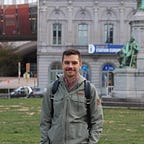Americans in Poland: The individual ties binding our two nations
What do a Quaker from Baltimore, a YWCA worker from San Francisco and a photographer from Pennsylvania have in common? They all contributed in some way to U.S.-Poland ties and are but three of the numerous American personalities whose stories are told in a special exhibit prepared for the centennial of bilateral relations. From aid workers and diplomats, to fighter pilots and journalists, the exhibit “Americans in Poland 1919–1947” highlights the numerous individuals who contributed to “Poland’s resurrection and survival” as exhibit authors Jan-Roman Potocki and Vivian Reed write.
Nestled behind the historic luxury Hotel Bristol, just aside from one of Warsaw’s most prestigious and popular streets — Krakowskie Przedmiescie — lies the History Meeting House, a unique exhibition space which hosts this special centennial display prepared in partnership with the U.S. Embassy in Warsaw. Among excellently prepared text and historic photographs are life-sized cutouts depicting these larger than life figures as well as artifacts from the period. One special object on display is the original seal from the U.S. Embassy in Warsaw which was saved in 1939 by then Ambassador Anthony Drexel Biddle, Jr.
While some of those profiled should be known to visitors and readers, such as Hugh S. Gibson, the first US envoy to Poland, famed American aviator Merian C. Cooper, and Herbert Hoover, the head of the American Relief Administration and later U.S. President; many others are deserving of greater recognition which this exhibit certainly offers.
Rebecca Janney, the aforementioned Quaker from Baltimore arrived in Warsaw in 1921 as part of the Quaker — American Friends Service Committee. This group worked throughout the post-war years to contain the typhus pandemic by setting up delousing and aid stations along the main border crossings on Poland’s eastern border, among other aid work. Martha Chickering, the Young Women’s Christian Association worker from San Francisco accompanied Polish-American women known as the Grey Samaritans to Poland where they supervised child canteens, clinics and orphanages. Julien Bryan’s name may not be known by all, but his photos are world famous. As the only foreign photographer in Warsaw during the September 1939 invasion of Poland, Bryan captured scenes of the unsung civilian victims of war, and his photographs would become iconic of Nazi Germany’s brutal invasion. It was Bryan who photographed the heart wrenching scene of a distraught 10-year-old Polish girl kneeling beside her dead sister who had just been shot by a German plane. His photographs and videos from the Siege of Warsaw would inform people everywhere of the horrors of this new war — a horror that was to be experienced by all too many around the world.
Another remarkable history was that Peter Dewey. His father was Charles Dewey, an Assistant Secretary of the Treasury who later served as an American advisor to the Polish Central Bank. Peter was a member of the Polish Boy Scouts and, as the exhibit explains, his four years in Warsaw in the 1920s instilled in him a love for Poland. In 1940, after the outbreak of World War II but before America’s official involvement in the conflict, Peter enrolled as a volunteer ambulance driver with the Polish Army in France. He later served in the U.S. wartime intelligence agency and was killed in Vietnam in 1945.
These are but some of the many who in one way or another became part of the US-Poland human fabric of relations. Many toiled to improve the situation of the people of newly independent Poland whose livelihoods had been ravaged by the “mini-apocalypse” of World War I and the poverty of the region. Some worked in offices and others out among the masses, but each in their own, unique way contributed to the ties between our two nations. How many mores names, known and unknown, were a part of that effort? With such organizations as the American Red Cross, the American Jewish Joint Distribution Committee, the YMCA, the YWCA, the Grey Samaritans, the Typhus Relief Expedition and many others, the human contribution to these efforts is all too worthy of recognition, especially during this centennial.
A stirring component of the exhibit is the reaction of American dignitaries who returned to a devastated Poland after 1945. “I have seen pictures of Warsaw, heard eye witnesses… but nothing gave me the slightest conception of the completeness of destruction” wrote Ambassador Gibson in his diary after visiting the Polish capital in 1946. Remarkably, many of the same American organizations which contributed to Poland’s recovery after World War I began to do the exact same thing after World War II, until Soviet domination prevented them from doing so further.
The exhibit’s authors, to their credit, do not shy away from the unfortunate truth, namely that “official relations between the two countries failed to reflect individual feelings” during this time period.
All the more so, those who mustered the courage and dedicated their time to help others deserve to be recognized for their efforts. “The individual ties binding our two nations over the last 100 years have proven the most resilient. It is well worth maintaining this extraordinary friendship” assert Potocki & Reed. This exhibit does a superb job in humanizing those ties and shining the spotlight on many incredible individuals.
In December, Drexel University will open a special exhibition at its Rincliffe Gallery celebrating Anthony J. Biddle Jr., the former U.S. Ambassador to Poland and one of the individuals profiled in “Americans in Poland.”
Anthony J. Drexel Biddle, Jr.: Citizen, Soldier, Diplomat.
An exhibition exploring the impressive life of Anthony J. Drexel Biddle, Jr., great-grandson of Drexel University founder, Anthony J. Drexel.
December 6, 2019 — March 13, 2020
This article was published in the October 2019 edition of the Polish American Journal
